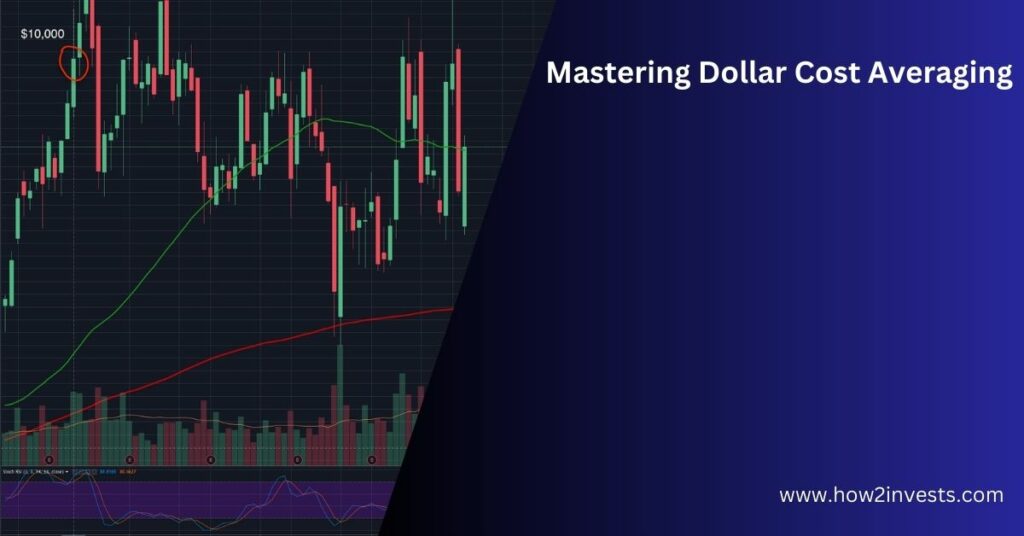Mastering Dollar Cost Averaging: A Strategic Approach to Long-Term Investing

In the dynamic world of investing, where market fluctuations can be as unpredictable as they are enticing, mastering the art of a strategic investment approach becomes crucial.
One such approach that has garnered significant attention and respect from investors is Dollar Cost Averaging (DCA). As a time-tested method, DCA offers a way to navigate the often turbulent waters of the financial markets while seeking to optimize long-term returns.
Understanding Dollar Cost Averaging:
Dollar Cost Averaging is an investment strategy where an individual invests a fixed amount of money at regular intervals, regardless of the current price of the investment.
This strategy is in contrast to attempting to time the market, which can be fraught with risks and uncertainties. Instead of trying to predict market highs and lows, DCA focuses on consistency and discipline.
Here’s how it works: Let’s say an investor decides to invest $500 in a particular stock every month. Regardless of whether the stock’s price is high or low, the investor purchases $500 worth of the stock.
When prices are high, the investor buys fewer shares, and when prices are low, the investor buys more shares. Over time, this approach evens out the cost basis and reduces the impact of market volatility on the overall portfolio.
The Benefits of Dollar Cost Averaging:
Risk Mitigation:
One of the primary benefits of DCA is risk mitigation. By investing a fixed amount at regular intervals, investors avoid the risk of making large investments at market peaks. This reduces the impact of market volatility on the overall portfolio.
Emotion Control:
DCA helps investors control their emotions. The fear of missing out (FOMO) during market rallies and the panic during market crashes can lead to impulsive decisions. DCA removes the need for emotional decision-making by sticking to a predetermined investment plan.
Long-Term Perspective:
DCA encourages a long-term perspective on investing. Instead of fixating on short-term market movements, investors can focus on the fundamental strength of their chosen assets and their long-term goals.
Consistency and Discipline:
Regular investing through DCA promotes financial discipline. It instills a habit of consistent investing, which can lead to significant wealth accumulation over time.
Averaging Out Cost Basis:
DCA allows investors to purchase more shares when prices are low and fewer shares when prices are high. Over time, this averaging effect can lead to a lower overall cost basis, potentially increasing returns when the investment appreciates.
Mastering the DCA Strategy:
To truly master the Dollar Cost Averaging strategy, investors should consider the following tips:
Choose the Right Assets:
While DCA can be applied to various assets like stocks, mutual funds, and cryptocurrencies, it’s important to choose assets with a solid growth potential and align them with your long-term investment goals.
Set a Regular Schedule:
Stick to a consistent investment schedule, whether it’s monthly, quarterly, or another interval that suits your financial situation.
Automate Investments:
Take advantage of automation tools provided by brokerage platforms. Automatic investments ensure that you remain disciplined and consistent.
Stay Informed:
Although DCA reduces the need to closely monitor daily market movements, staying informed about the broader economic trends that could affect your investments is still important.
Adjust as Needed:
While DCA promotes consistency, life circumstances and market conditions can change. Be prepared to adjust your investment amounts if necessary.
Maximizing DCA: Leveraging Market Dips for Advantage
One of the key advantages of Dollar Cost Averaging is the ability to capitalize on market downturns. When prices of your chosen assets are lower, your fixed investment amount can purchase more shares.
This means that during bear markets or when individual stocks experience temporary declines, you can benefit by accumulating more shares for the same investment amount.
To maximize this aspect of DCA, consider the following:
Market Research:
Keep an eye on the market and specific assets you’re investing in. When you notice a general market dip or a specific asset’s price decline that isn’t related to its fundamentals, consider increasing your investment amount temporarily to take advantage of the lower prices.
Volatility as an Opportunity:
Instead of fearing market volatility, view it as an opportunity. During times of heightened volatility, price fluctuations can be more pronounced, providing a chance to accumulate assets at more attractive prices.
Emergency Funds:
Ensure that your emergency fund is in place before increasing your DCA investments during market dips. This way, you won’t need to tap into your investments unexpectedly due to personal financial emergencies.
Combining DCA with Fundamental Analysis:
While DCA primarily focuses on consistency and time, combining this strategy with fundamental analysis can potentially enhance your investment decisions. Fundamental analysis involves assessing an asset’s intrinsic value based on factors like financial statements, industry trends, and competitive positioning.
Here’s how you can incorporate fundamental analysis into your DCA approach:
Asset Selection:
Choose assets with strong fundamentals that align with your investment goals. Look for companies or assets with solid growth potential, strong financials, and a competitive edge.
Regular Check-ins:
While DCA encourages a less frequent monitoring of the market, it’s still valuable to periodically review the fundamental health of the assets you’re investing in. This ensures that your chosen assets continue to align with your investment strategy.
Rebalancing Opportunities:
If your fundamental analysis reveals that an asset’s intrinsic value has significantly changed, consider adjusting your DCA strategy accordingly. For instance, if an asset’s fundamentals improve, you might consider increasing your investment amount.
DCA in Volatile Markets: Navigating Uncertainty with Confidence
Investing during periods of market volatility can be daunting, but Dollar Cost Averaging can provide a sense of confidence and control even in uncertain times.
Volatile markets are characterized by rapid price swings, often driven by external events or investor sentiment. Here’s how you can navigate such situations using DCA:
Stick to the Plan:
In volatile markets, emotions can run high, leading to impulsive decisions. Stick to your DCA plan and continue making your regular investments. This disciplined approach can help you avoid making hasty choices driven by fear or FOMO.
Avoid Timing Attempts:
Trying to time the market during periods of high volatility is particularly risky. DCA eliminates the need to predict market movements, as your fixed investments continue regardless of short-term fluctuations.
Market Opportunities:
Volatile markets can sometimes create opportunities to buy quality assets at lower prices. Your DCA approach can take advantage of these opportunities by automatically increasing your exposure to assets that have temporarily decreased in value.
Conclusion:
Dollar Cost Averaging is a versatile investment strategy that offers multiple avenues for enhancing its effectiveness. By leveraging market dips, combining it with fundamental analysis, and navigating volatile markets, investors can truly master the art of DCA.
While the strategy requires patience and a long-term perspective, the potential benefits in terms of risk reduction and wealth accumulation make it a valuable tool for both novice and experienced investors alike.
Also Read:
- Unlocking Opportunities Käntäjää: The Translator Investment Advantage
- Unveiling the Käntäj Investment Plan: A Roadmap to Financial Success
- Kääbntäjä : A Guide to Money Investment”
- How Are Bozullhuizas Partners Ltd? Business Model, Services, and Reputation
- Unveiling the Mystery: The Enigmatic World of 2045996879





